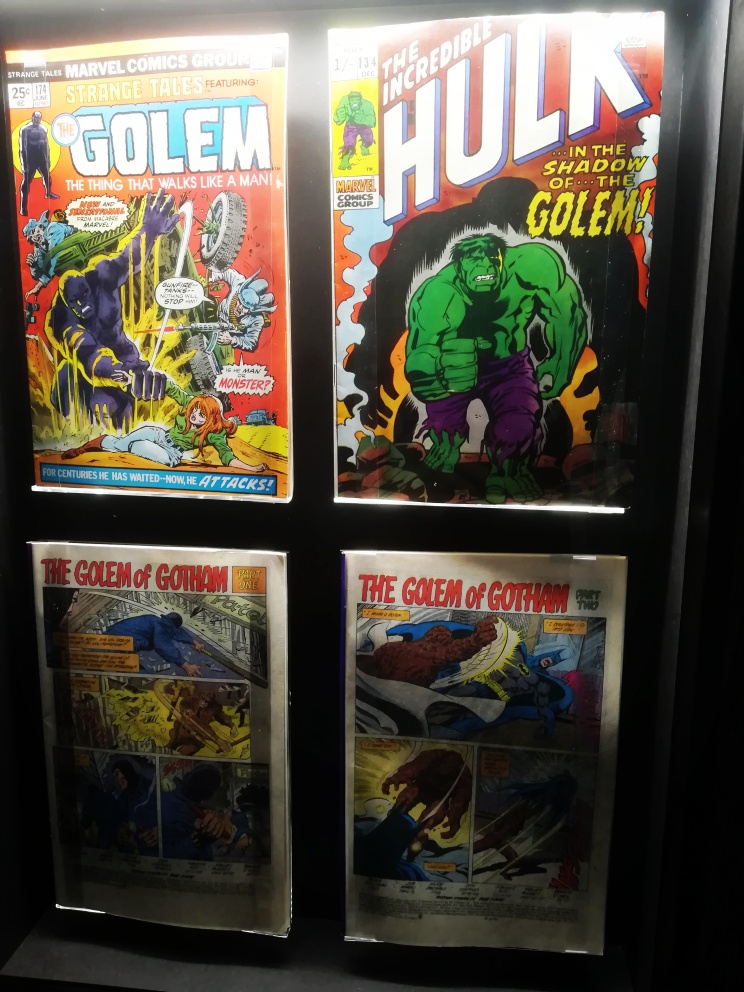The Barbican is currently running a centre wide exhibition looking at Artificial Intelligence (AI). The AI: More Than Human exhibition looks at the complex relationship between humans and machines, asking us what it really means to be human. To answer this question the exhibition brings together people from a variety of disciplines including scientists, artists, philosophers and researchers and offers an often interactive way to engage with this most heady of topics.
As I was early, I explored the various interactive installations that were housed around the hall before entering the exhibition proper.
Along the long Silk Street corridor, there were two large screens with what looks like atoms connected. There was a spot on the floor with footprints and when you stood on it and moved your limbs the atomic structure changed. It reminded me of an Xbox Kinect experience, so not too flashy but there were several young children who were engaged and were fascinated that they were an active agent for what occurred on the screens. The vision of Barbican in 2065 through a three screened walking simulator was interesting, as it showed the brightly lit cityscape strewn with wind turbines, but I felt like it missed a trick by not using a VR headset. The sense of immersion would have been greater with this medium utilised.
Down in the Pit, was the highlight of the interactive exhibitions, teamLab’s ‘What a Loving and Beautiful World’. It contained projectors which interacted with people's shadows and movements to create an output, be it trees growing, pink cherry blossom drifting by slowly or birds flying. It was wonderful and quite meditative and an early highlight.
Thoroughly impressed, I then entered the ticketed part of exhibition and saw that it was split into 4 sections:
The dream of AI,
Mind machines,
Data worlds, and
Endless evolution.
In the first section, The Dream of AI, I was greeted with a provenance that stated that there were many tales of non-living things coming to life through magic, science, religion or Illusion.
Comic books, religious texts, alchemical paraphanalia, models and figures were displayed to show how, throughout history, this has been a large area of interest for humans, whether to understand what life is, play God or to extend life and cheat death.
A sepia toned video installation titled AE/MAETH by Hurlig and Weitz was a stunning look at how much AI, cyborgs, golems and the like have become a part of pop culture, transcending its Judaic origins from Rabbi Loew's 16th century golem story.
The Japanese belief of Shinto and animism is explored as inanimate objects are said to have kami, a life force, which means that Japanese culture is more accepting of the concept of AI, thus the prevalence of characters such as Astrobot and Doaromon in their pop culture.
This section had a few film clips from Frankstein, Blade Runner, Der Golem, Ex Machina and much more to show how the fear of AI has been a long running human preoccupation.
The next section, Mind Machines explained how AI developed through history and had much on show, from Babbage's Analytic Engine, the first 'computer' which was powered by steam to Turing's The Bombe Enigma code breaking machine used in the film, 'The Imitation Game.' The video wall with a time line of breakthroughs and achievements was great to follow but with such a large crowd it was difficult to read everything and take it in.
In Data Worlds, the ability of AI to change society was examined. As I entered there was a racing video game and next to that a screen where your reactions were monitored and the emotion you were sensed to be feeling shown on screen. There were a variety of different neural networks on show, which you could interactive with. Issues such as racial bias and privacy were explored. The Future of Life letter, which argued against the use of AI controlled weapon systems was on show, undersigned by Bill Gates, Stephen Hawking, Elon Musk and Steve Wozniak amongst many others, highlighted the very real danger that AI could pose if not properly controlled.
The final part, Endless Evolution, looked at the future of the human race. It showcased a robot interacting with people as they passed a few video installations of where AI should be going and the future of artificial life.
As a whole, the exhibition is interesting and engaging but it is all a bit overwhelming. There is so much to see and hear that you need a good couple of hours to appreciated it fully. Some of the videos looked interesting but the ambient noise level made it difficult to hear anything clearly. So, is it worth the money? Well, I enjoyed it but did find it not as well organised or curated as the Robot Exhibition from a couple of years ago at the Science Museum. It's worth a look if this is a field of interest but for the casual onlooker I don't think it will appeal.
LINK- Manga Exhibition at British Museum Review
LINK: Japan: My Journey to the East
LINK- Battle Angel Alita: And So It Ends
LINK- The Moomins 80's Soundtrack Vinyl Review
LINK- Inspector Gadget Retro Soundtrack Review
LINK- Ulysses 31 Retro Soundtrack Review
LINK- The Mysterious Cities of Gold Retro Soundtrack Review






















